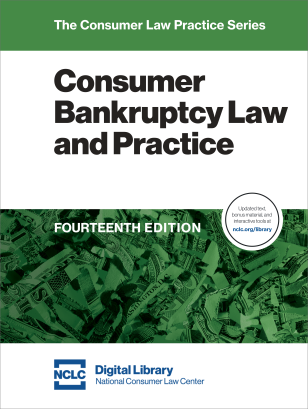Notice of Change As to Mortgage Payment Amount for HELOCs
The payment amount on a mortgage being paid during a chapter 13 case can change, usually because of an annual escrow account analysis or an interest rate adjustment on a variable rate mortgage. Bankruptcy Rule 3002.1(b) requires mortgage creditors to send payment change notices no later than twenty-one days before a new payment amount is due. Notice must be given on Official Form 410S-1, the Notice of Mortgage Payment Change (reproduced at NCLC’s Consumer Bankruptcy Law and Practice Appendix D.4).
Mortgage servicers have argued that the payment change notice requirements are burdensome for home equity lines of credit (HELOCs), because the payments on such mortgages may change monthly and in small amounts. As discussed in NCLC’s Consumer Bankruptcy Law and Practice § 11.6.2.8.2.3, some courts have refused to exempt HELOCs, finding that compliance with the rule is mandatory or that courts lack authority to extend the time deadlines. In response to these concerns, Rule 3002.1(b) is now amended to provide that the notice requirements for HELOCs “may be modified by court order.”
The Advisory Committee Note issued with the amendment to Rule 3002.1 (reproduced at NCLC’s Consumer Bankruptcy Law and Practice Appendix B) states that it was intended to provide “flexibility for courts to specify alternative procedures” for providing payment change notices for HELOCs. For example, the court could require that payment change notices on HELOCs be sent biannually or annually rather than at the time of every change, if the total amount of the installment payment adjustments for the period does not exceed $10. If a court modifies the payment change requirements for HELOCs, the rule requires that the modifications be set out in a court order. The advisory committee note explains that this may be done through the adoption of a local rule or the entry of orders in individual cases.
Procedure to Dispute Changes in Mortgage Payment Amount
When Rule 3002.1 was initially adopted, it did not specify the procedure a party in interest would use to challenge a payment change notice. This is now clarified by the new rule amendments. If the debtor, chapter 13 trustee, or any party in interest disputes that a payment change is required, new Bankruptcy Rule 3002.1(b)(2) (reprinted at NCLC’s Consumer Bankruptcy Law and Practice Appendix B) requires that the party file a motion requesting that the court determine whether the change is required.
The party filing the motion should state the reasons why the payment change is not required, and if applicable, refer to any provisions of the underlying mortgage agreement or non-bankruptcy law that support the party’s position. The motion should be served in accordance with Bankruptcy Rule 9014, which incorporates the service of process rules under Bankruptcy Rule 7004.
Bankruptcy Rule 3002.1(b)(2) does not set a deadline for when the motion must be filed. However, if a motion challenging a payment change is not filed by the day before the new amount is due, the payment change will go into effect, unless a court orders otherwise. The date the new amount is due should be stated on the payment change notice. If the motion is filed before the new amount is due and there is no contrary court order, the advisory committee note states that the payment change will be suspended until the court determines whether the change is required. See NCLC’s Consumer Bankruptcy Law and Practice Appendix B.
The timing of the motion therefore can affect the debtor’s payment obligation. If the motion is filed after the payment change goes into effect and the court later determines that the change was not required, the advisory committee note states that “appropriate adjustments will have to be made to reflect any overpayments.” The adjustments could take various forms, such as a credit on payments that come due after the court determination, a refund to the debtor or trustee (if the trustee is disbursing ongoing mortgage payments), or a recalculation of the escrow or interest portion of the mortgage payment following an escrow account or interest rate analysis.
The court’s determination may also require the mortgage creditor to send another payment change notice if the adjustments result in a different payment amount. If, however, the payment change was suspended because a motion was filed before the new amount came due, and a court determines that the change was in fact required, the debtor will need to address any underpayment. The debtor could pay the amount in a lump sum, enter into a repayment agreement with the mortgage servicer, or propose to amend the plan to provide for payment of the underpayment.
In any proceeding for a determination under Rule 3002.1(b)(2), the creditor has the burden of proof to establish that the payment change is required even though the motion is filed by the debtor or other party in interest. This is because Rule 3002.1(d) provides that a payment change notice, which is the subject of the dispute, is not entitled to a presumption of validity under Rule 3001(f).
Changes to Electronic Filing and Signing of Documents
As discussed in NCLC’s Consumer Bankruptcy Law and Practice § 7.1.4, all of the bankruptcy courts have adopted procedures and systems to permit the electronic filing of documents. Prior to the December 1 rule amendments, Bankruptcy Rule 5005 authorized bankruptcy courts to adopt local rules to require electronic filing, but only if reasonable exceptions were allowed. Rule 5005 now makes electronic filing mandatory in all districts for attorneys, though local courts still retain authority to grant certain exceptions. The rule now states that an entity represented by an attorney shall file electronically, unless non-electronic filing is allowed by the court “for good cause or is allowed or required by local rule.”
Different requirements have been established for pro se debtors and other unrepresented individuals. New Bankruptcy Rule 5005(b), is reprinted at NCLC’s Consumer Bankruptcy Law and Practice Appendix B. On the one hand, Rule 5005(b) now provides that an unrepresented individual may file electronically only if allowed by court order or by local rule. On the other hand, a court can require an unrepresented individual to file electronically, but only by court order or by a local rule that includes reasonable exceptions. The advisory committee note issued with the amendment states that courts should take care to “ensure that an order to file electronically does not impede access to the court.”
With respect to the signing of documents, new Bankruptcy Rule 5005(c) provides that a court filing made through a person’s electronic-filing account and authorized by that person, and which includes the person’s name on a signature block, constitutes the person’s signature.
Twelve Amended Rules Concerning Appeals from Bankruptcy Court to Federal District Court
Effective December 1, 2018, twelve bankruptcy rules have been amended relating to appeals from a bankruptcy court to a federal district court. These changes are all to Part VIII of the Bankruptcy Rules of Procedure and are found at the digital version of NCLC’s Consumer Bankruptcy Law and Practice Appendix B.
Length Limits [Rules 8013, 8015, 8016, 8022, and Part VIII Appendix]. In 2016, numerous changes were made to the Federal Rules of Appellate Procedure related to length and word limits for motions, briefs and other pleadings. Amendments to Bankruptcy Rules 8013, 8015, 8016, and 8022 conform the Bankruptcy Appellate Rules to the Federal Rules of Appellate Procedure. A new Appendix to Part VIII sets forth the various length limits in table format. Further, the rules specify items excluded from the length limitation (e.g., corporate disclosure statement and table of contents) and require a certificate of compliance.
Timeliness of Tolling Motions [Rule 8002(b)]. Rule 8002(b) sets out a list of postjudgment motions that toll the time for filing an appeal. The new amendment conforms the rule to Federal Rule of Appellate Procedure 4(a)(4), which requires such postjudgment motions to be filed within the time period specified by the rule under which it is made in order to have a tolling effect.
Running of the Appeal Period [Rule 8002(a)]. To alleviate confusion over when a judgment or order is entered for purposes of the appeal period, Bankruptcy Rule 8002(a) is amended to add new subdivision (a)(5). The new subdivision is similar to Federal Rule of Appellate Procedure 4(a)(7) and specifies that the time for filing an appeal begins to run upon docket entry in contested matters and adversary proceedings for which Rule 58 does not require a separate document. In an adversary proceeding for which Rule 58 does not require a separate document, the time begins when the judgment, order, or decree is entered on the civil docket and (1) it is set forth on a separate document or (2) 150 days have run from the entry in the civil docket, whichever occurs first.
Filing and Service; Signature [Rule 8011]. Bankruptcy Rule 8011 is amended to conform with newly amended Bankruptcy Rule 5005, which requires electronic filing, except for filings made by an individual not represented by an attorney. Exceptions continue to be available and paper filing must be allowed for good cause. Subdivision (d) eliminates the requirement of proof of service when service is made through the electronic-filing system. Subdivision (e) requires the signature of counsel or an unrepresented party on every document that is filed. A filing made through a person’s electronic filing account and authorized by that person, together with that person’s name on a signature block, constitutes the person’s signature.
District Court Review of Judgment That Bankruptcy Court Lacked Constitutional Authority to Enter [Rule 8018.1]. Amended Bankruptcy Rule 8018.1 authorizes a district court to treat a bankruptcy court’s judgment as proposed findings of facts and conclusions of law if the district court determines that the bankruptcy court lacked constitutional authority to enter a final judgment. The rule eliminates the need for a remand to the bankruptcy court for the entry of proposed findings and conclusions of law.
Direct Appeals—Court Statement on Merits of Certification [Rule 8006(c)]. Amended Bankruptcy Rule 8006(c) authorizes, but does not require, a court to file a short supplemental statement regarding the merits of certification for direct appeal when the parties certify the appeal.
Amicus Filings [Rule 8017]. Amendments to Bankruptcy Rule 8017 contain two significant changes. First, new subdivision (b) governs amicus briefs when a district court or bankruptcy appellate panel considers whether to grant rehearing. Previously, the rule only addressed amicus briefs submitted during the court’s initial consideration of a case on the merits. Second, subdivision (a) authorizes a court to prohibit or strike the filing of an amicus brief to which the parties consented if the filing would result in the disqualification of a judge.
Inmate Filing Provisions: [Rules 8002(c), 8011(a)(2)(C)]. Bankruptcy Rules 8002(c) and 8011(a)(2)(C) are amended to conform with Federal Rules of Appellate Procedure 4(c) and 25(a)(2)(C). They treat notices of appeal and other papers as timely filed by inmates if the documents are deposited in an institution’s internal mail system on or before the last day for filing and several other specified requirements are satisfied. See also new Declaration of Inmate Filing, Director’s Procedural Form B 4170, reprinted at NCLC’s Consumer Bankruptcy Law and Practice Appendix E.15.
Modernizing Bond and Surety Terminology [Rules 8007, 8010, 8021]. Amendments to Bankruptcy Rules 8007, 8010, and 8021 conform the Bankruptcy Rules to the Federal Rules of Appellate Procedure, which modernize the terminology “supersedeas bond” and “surety.” The revised rules refer to bonds or other security.



